4A0-110 Exam Details
-
Exam Code
:4A0-110 -
Exam Name
:Alcatel-Lucent Advanced Troubleshooting -
Certification
:Nokia Certifications -
Vendor
:Nokia -
Total Questions
:40 Q&As -
Last Updated
:Jan 05, 2026
Nokia 4A0-110 Online Questions & Answers
-
Question 1:
Refer to the diagram below, what encapsulation type and VLAN tag are required at point X for the PC to ping the IES interface?
A. qinq sap 1/1/1:6.0
B. qinq sap 1/1/1:6.*
C. dot1q sap 1/1/1:6
D. null sap 1/1/1
E. There is no way to make ping works in this case -
Question 2:
Which one of the following routes should be the best BGP route according to the Alcatel VPRN route selection criteria?
A. The 1st route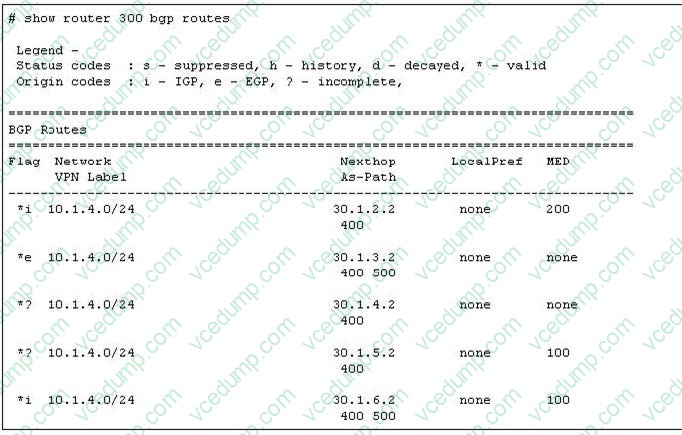
B. The 2nd route
C. The 3rd route
D. The 4th route
E. Node of the above -
Question 3:
VPRN 300 is configured on Node 3 and Node 4 with LDP and MP-BGP. No route can be found in the VPRN 300 routing table on both Nodes. What is the cause of the problem?
A. No static route configured on Node 4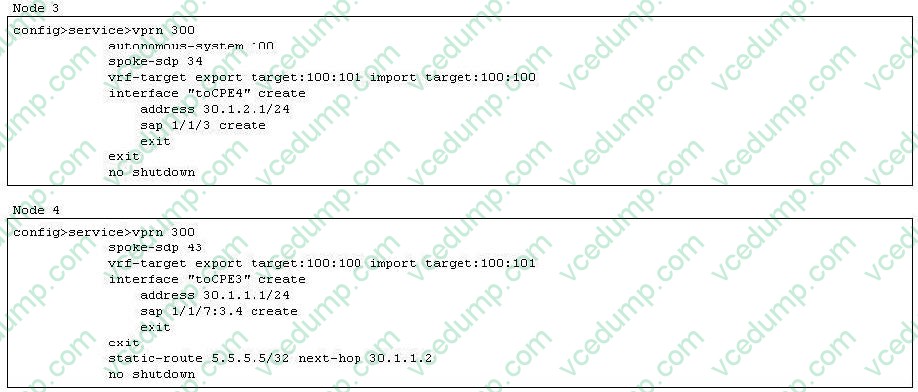
B. No LDP defined in the VPRN configuration on both nodes
C. VRF-target does not match on Node 3 and Node 4
D. Route-distinguisher configuration is missing on Node 3 and Node 4
E. Encapsulation type on the SAP does not match on Node 3 and Node 4 -
Question 4:
VPRN 300 is configured between Node 3 and Node 4. Node 4 receives VPN routes from Node 3 and imports them into the VRF. The entire route-table is displayed below for VPRN 300 on Node
4. When attempting a ping from VPRN 300 on Node 4 to 30.1.1.1 the ping fails. A ping from Node 3 within VPRN 300 to 30.1.1.1 is successful. What is the cause of the problem?
A. No local interface existed in VPRN 300 route-table on Node 4
B. Syntax problem in the ping command
C. Prefix 30.1.1.1 does not exist on the far-end
D. Source address has to be specified in the ping command
E. Next-hop address has to be specified in the ping command -
Question 5:
VPRN 300 is configured on Node 4. BGP is being used as the PE-CE routing protocol. Node 2 is the CE router. The BGP session is not established between Node 4 and Node 2. What is missing in the configuration?
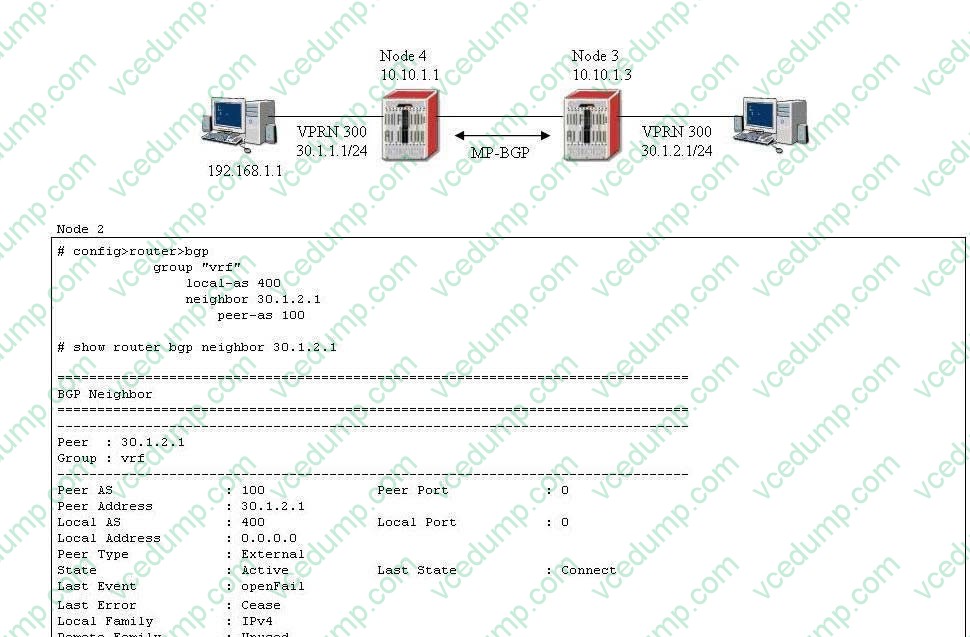
A. Type external has to be configured on Node 2 under group vrf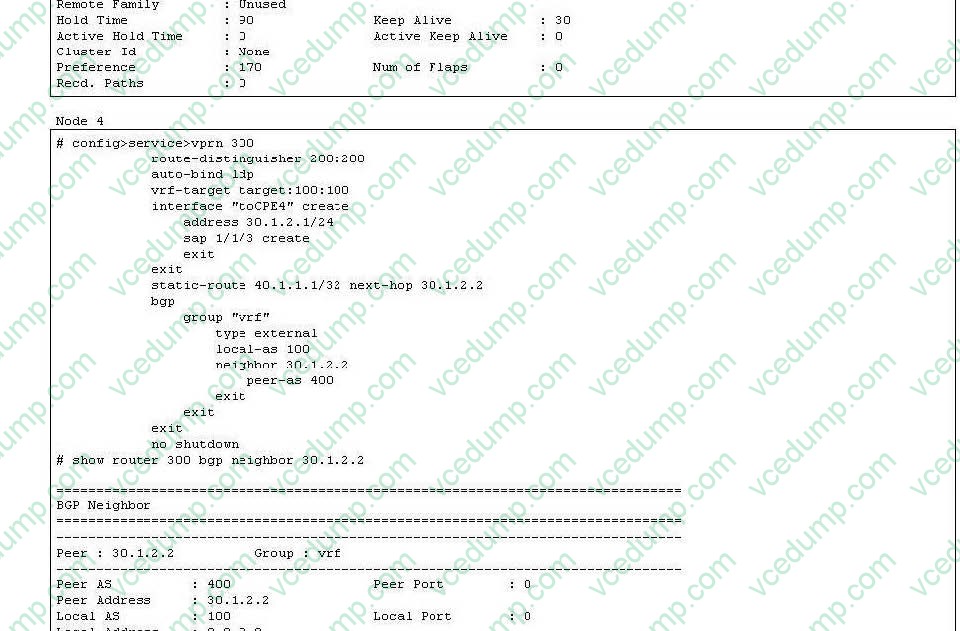
B. Autonomous-system has to be configured on Node 4 under vprn 300
C. Router-id has to be configured on Node 4 under vprn 300
D. Router-id has to be added under BGP on Node 2
E. EBGP will not work under VPRN -
Question 6:
Based on the following MP-BGP update packet, what is the export route-target of peer 10.10.1.4 on Node 1?
A. 100:100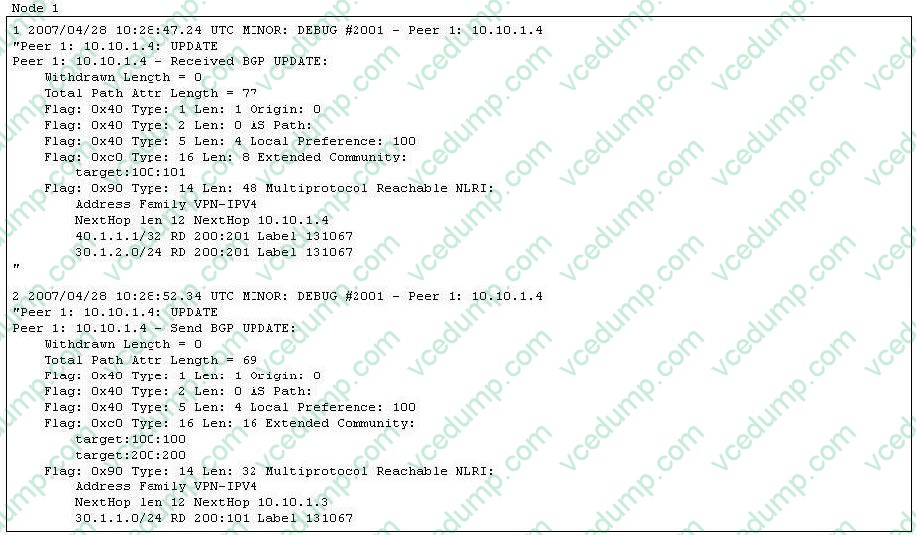
B. 100:100 and 200:200
C. 200:200
D. 100:101
E. 200:101 -
Question 7:
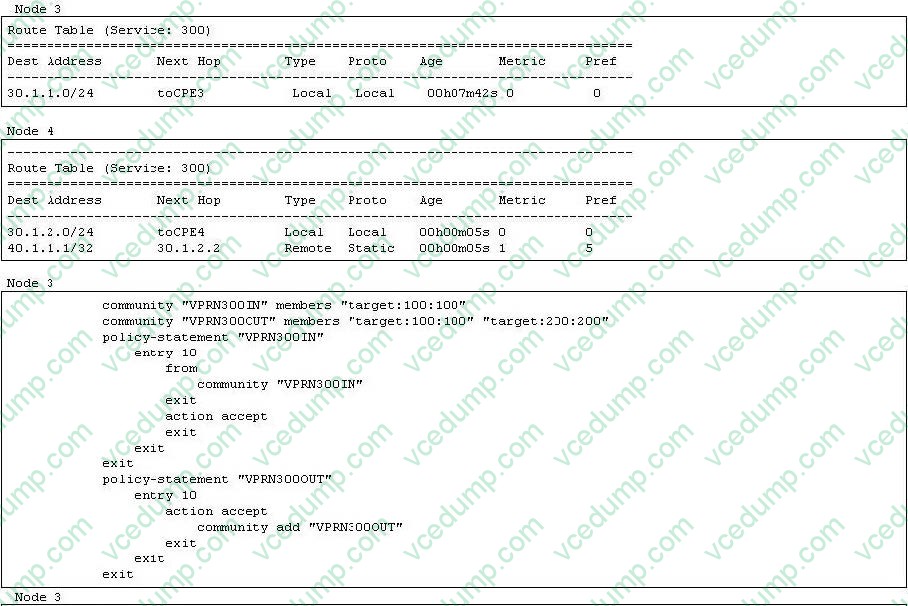
A. VRF policy configured on Node 3 does not match with vrf-target configured on Node 4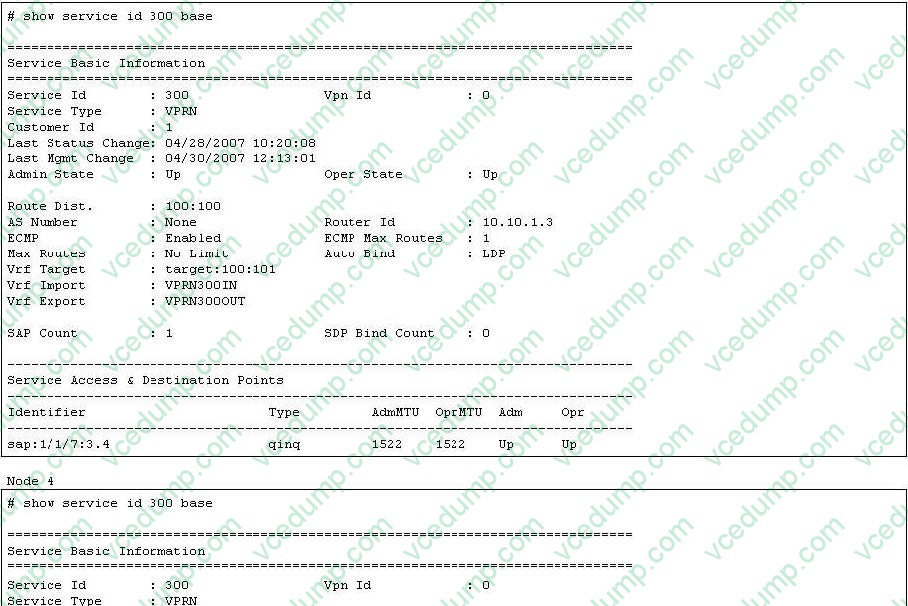
B. No SDP defined in the VPRN configuration on both nodes
C. VRF-target mismatch on Node 3 and Node 4
D. Route-distinguisher mismatch on Node 3 and Node 4
E. Encapsulation type mismatch on SAPs on Node 3 and Node 4 -
Question 8:
Node 1 receives some VPRN routes from Node 2, but Node 2 is not receiveing any VPRN routes from Node 1. Routes in VPRN 400 route table are found on Node 1 as follows: Based on the configuration below, why is Node 2 not receiving BGP VPN routes from Node 1?
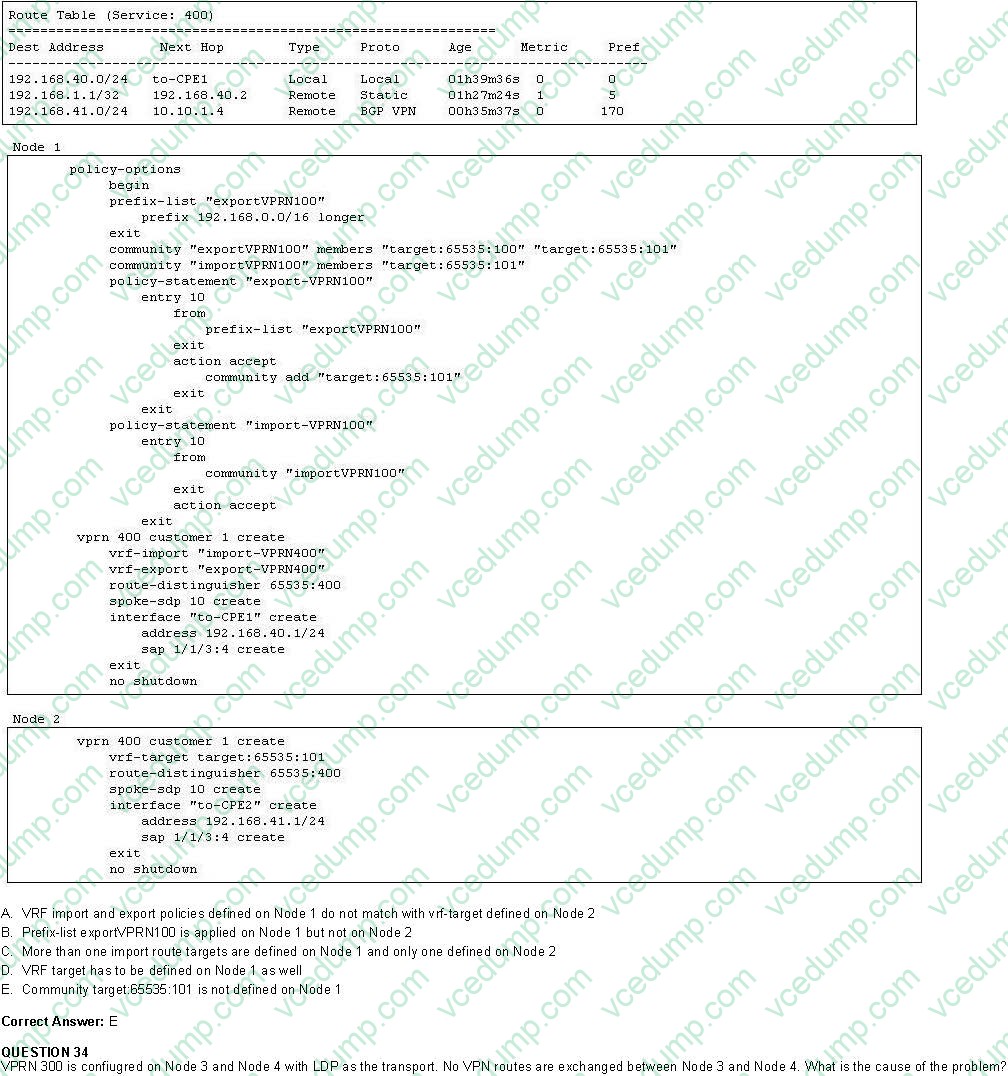
VPRN 300 is confiugred on Node 3 and Node 4 with LDP as the transport. No VPN routes are exchanged between Node 3 and Node 4. What is the cause of the problem?
A. VRF import and export policies defined on Node 1 do not match with vrf-target defined on Node 2
B. Prefix-list exportVPRN100 is applied on Node 1 but not on Node 2
C. More than one import route targets are defined on Node 1 and only one defined on Node 2
D. VRF target has to be defined on Node 1 as well
E. Community target:65535:101 is not defined on Node 1 -
Question 9:
Which command can be used to view all interfaces configured under VPRN 300?
A. Show router interfaces
B. Show router interface vprn 300
C. Show router 300 interfaces
D. Show service vprn 300 interfaces
E. Show service id 300 interfaces -
Question 10:
An operator has entered the following CLI commands to configured redistribution of OSPF routes into ISIS. None of the active OSPF routes are redistributed into ISIS, what is the problem in the CLI commands?
A. OSPF area has to be configured as NSSA
B. Default-action has to be configured as accept
C. Import policy has to be configured under OSPF
D. The policy is still in edit mode, therefore it will not take any effect
E. to protocol isis has to be added under entry 10
Related Exams:
-
4A0-100
Nokia IP Networks and Services Fundamentals -
4A0-101
Nokia Interior Routing Protocols -
4A0-102
Nokia Border Gateway Protocol for Internet Routing -
4A0-103
Nokia Multiprotocol Label Switching -
4A0-104
Nokia Services Architecture -
4A0-105
Nokia Virtual Private LAN Services -
4A0-106
Nokia Virtual Private Routed Networks -
4A0-107
Nokia Quality of Service -
4A0-108
Nokia Multicast Protocols -
4A0-109
Alcatel-Lucent Triple Play Services
Tips on How to Prepare for the Exams
Nowadays, the certification exams become more and more important and required by more and more enterprises when applying for a job. But how to prepare for the exam effectively? How to prepare for the exam in a short time with less efforts? How to get a ideal result and how to find the most reliable resources? Here on Vcedump.com, you will find all the answers. Vcedump.com provide not only Nokia exam questions, answers and explanations but also complete assistance on your exam preparation and certification application. If you are confused on your 4A0-110 exam preparations and Nokia certification application, do not hesitate to visit our Vcedump.com to find your solutions here.